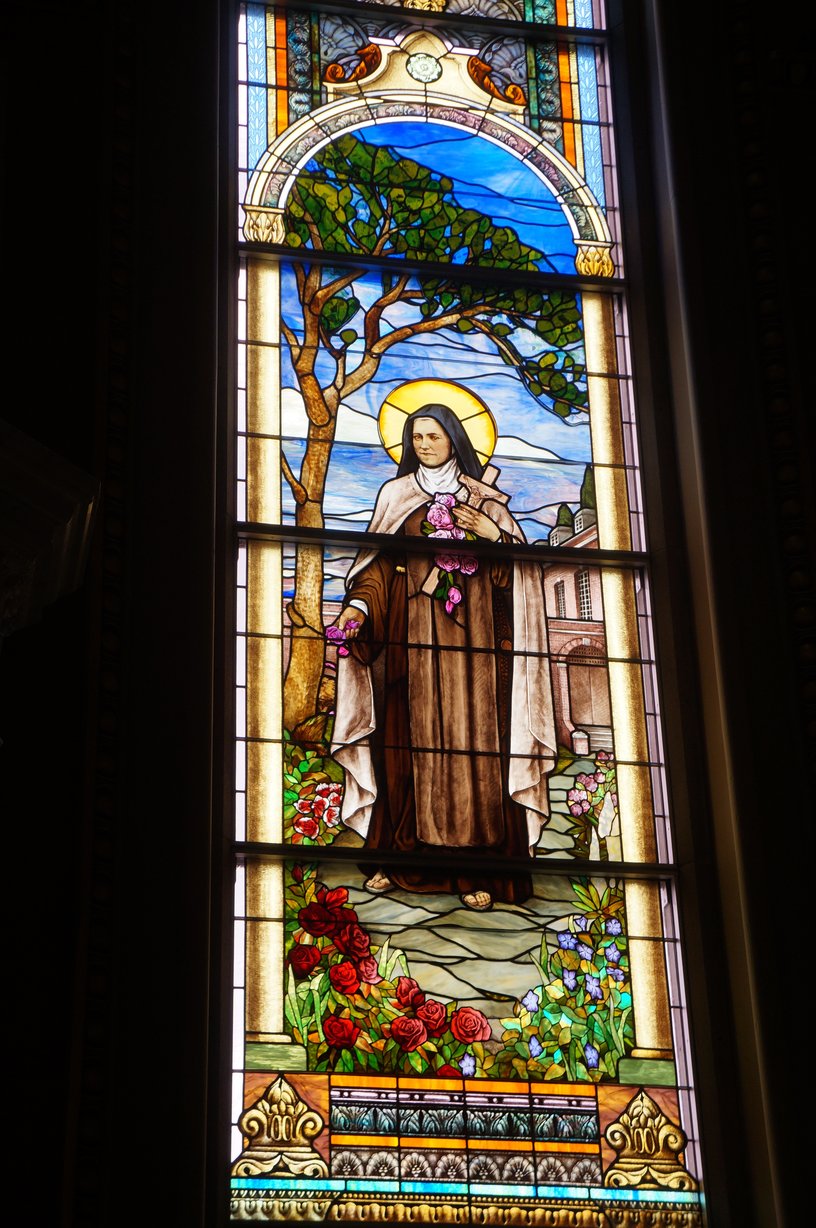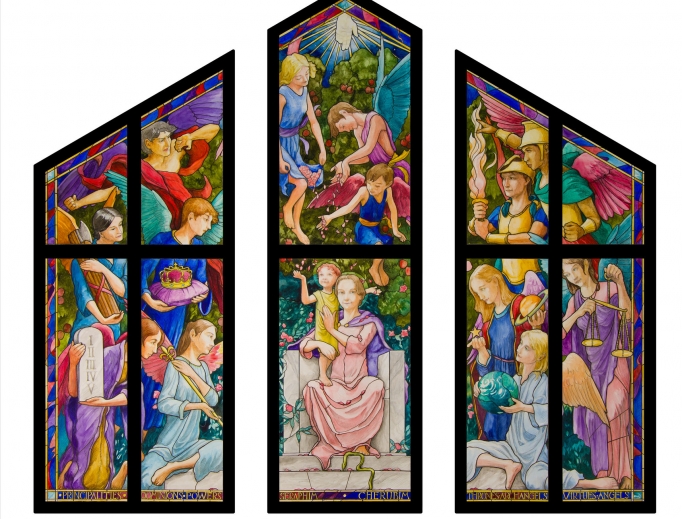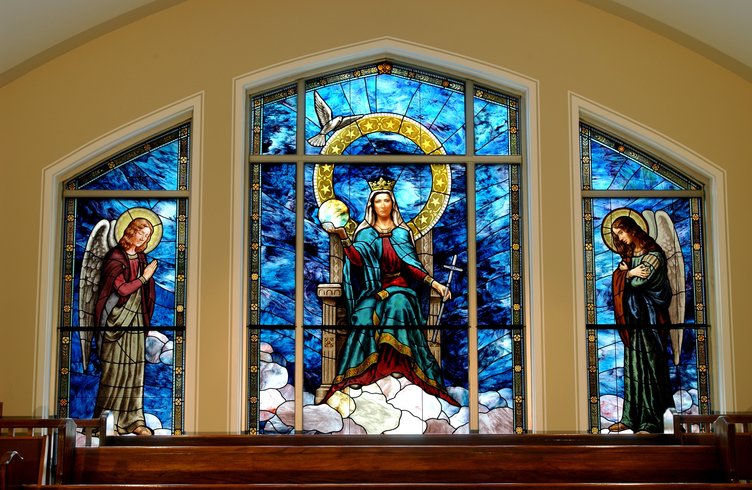Light Show: Renaissance of Stained Glass Underway in Sacred Spaces
Beauty in glass is making a comeback.

When St. Peter Catholic Church in Volo, Illinois, wanted a huge stained-glass window of Our Lady of Guadalupe appearing to Juan Diego done in the traditional 19th-century Munich style once predominant in American churches, the parish turned to Daprato Rigali Studios in Chicago. When St. Joseph Church in Downingtown, Pennsylvania, needed recently acquired original Munich windows restored and several new ones made to match, the church looked to the expertise of Beyer Stained Glass Studio in Philadelphia. Similarly wanting to replicate windows in the Munich style to replace ones that formerly graced the church before their removal in a 1960s renovation, St. Stanislaus Oratory in Milwaukee enlisted the skills of Conrad Schmitt Studios in New Berlin, Wisconsin.
“People are seeking out very clear figural art, lovely to look at and that connects them to the great tradition of the church,” explained liturgical art expert Denis McNamara, academic director and associate professor of The Liturgical Institute at the University of St. Mary of the Lake in Mundelein, Illinois. He sees this revival paralleling the whole recovery of traditional architecture in the churches. “There’s a renaissance of the whole allied arts of architecture,” which include stained glass and oil painting, he reported. The revival in traditional-style stained glass is “part of the larger renaissance of the recovery of the beauty of it all.”
Joseph Beyer, artist and president of Beyer Stained Glass Studio (BeyerStudio.com), said, “There has been a renaissance of architecture in the past 20 years that began in the South and moved north. All of the things in the ’60s, ’70s and ’80s are a thing of the past.”
Similarly, Dan Rigali of Daprato Rigali Studios (DapratoRigali.com) finds the same demand, as “more and more people prefer that traditional Bavarian, Munich stained-glass style over all the other styles. It captivates the congregation and feels more holy and closer to God.”
Revival’s Two Sides
One side of this revival is the artistry of making new stained-glass windows in the traditional style, and the other is in restoring timeworn original windows, or installing them into a new church by saving them from a closed church. The majority of the latter are from those of the same Munich-style school and, in nearly all cases, from the companies of Franz Mayer and F.X. Zettler, relatives who later combined as Mayer & Co. Papal approval of these companies’ works were one factor for their prodigious popularity beginning in the 19th century. So were their beautiful opulent colors, lavish ornamentation and spiritual richness, emulating the great Masters in oils. Both companies eventually opened offices in the United States, as did the Tyrolese Art Glass Company in Innsbruck, Austria, with its similar artistic style.
Because of this style’s realism, “people are able to see themselves in the windows and able to relate to the scene or the feeling the windows depict,” said Rigali. “That way people know they’re dealing with serious art and the windows have relatable people.” Consequently, biblical and Gospel scenes come alive.
“There’s a sense of the sacred you get when you step into a traditional church and you’re aesthetically rooted in that tradition,” said Kevin Grabowski, national projects director of Conrad Schmitt Studios (ConradSchmitt.com).
Indeed, the Catechism of the Catholic Church (1161) has something to say about the place of sacred images in worship. “All the signs in the liturgical celebrations are related to Christ: as are sacred images of the holy Mother of God and of the saints as well. They truly signify Christ, who is glorified in them. They make manifest the ‘cloud of witnesses’ who continue to participate in the salvation of the world and to whom we are united, above all in sacramental celebrations.”
In addition to stained-glass restorations, Grabowski said the studio is working on traditional-style windows for classically designed churches such as the recently built St. John the Evangelist Church in Waynesboro, Virginia. A sampling of the sacred spaces that feature the company’s stained glass are several buildings at the University of Notre Dame, such as depictions of the Blessed Mother, St. Patrick and St. Francis in one of the halls.
For the recent restoration of the 19th-century St. Stanislaus Oratory in Milwaukee, which saw its traditional stained-glass windows replaced in the 1960s by solid-colored glass, Grabowski said the studio “designed Munich-style figural windows that look like they have always been there.” Among the new traditional windows in the Munich style are ones honoring Our Lady of Fatima, St. Thérèse of Lisieux and St. Patrick.

“We can replicate verbatim — exactly,” he said, “because of doing so much restoration work.”
Beyer is of the same mind when it comes to the historic Munich-style windows and the artistry of their current replicas and originals. His staff research and experiment to get the look just right, using the finest materials, including the best glass available. “We are often called upon to make new windows in the same style,” Beyer explained, turning to a recent example still underway: St. Joseph Catholic Church in Downingtown, Pennsylvania, bought nine original Munich windows from the Philadelphia Archdiocese crafted by artist George Boos. “They needed seven more windows like that and wanted subject matter that didn’t appear in any church,” Beyer explained. “One was [depicting] ‘St. Joseph’s Dream.’ We had to design something in the style of this artist.” One of the studio’s artists perfectly replicated the Munich artist’s style for this new window that pictures a sleeping Joseph, an angel opening a curtain to present to him the scene of marriage to Mary, all surrounded by the reproduced Munich-style border of observing angels, florals and designs in a highly ornamental frame matching the originals.
As he said, “Because the old ones are completely restored, you can’t tell the difference between the old and the new.”

Also in the works: The Innsbruck company’s creations will be showcased in the new chapel at Christendom College, Front Royal, Virginia, following restoration and resizing by the studio to fit the new space.
The renaissance of traditional stained-glass windows has little to do with nostalgia. Whether historic and original, new replications, or a combination of both, these stained-glass windows have a major place in liturgical life. “The style of the windows from a long time ago shows a consistency across the worship and religion of the Catholic faith,” explained Rigali, referring to both Munich-style creations and the art of centuries earlier.

“These represent really serious parts of our faith and worship. People feel they’re ‘home’ and in a special worship place.”
According to Beyer, “Stained glass has always been associated as a spiritual medium beyond any other art form and remains associated with religious architecture.”
McNamara emphasized that, traditionally, stained glass has been called “the only art truly developed by Christianity. Nobody invented a stained-glass window until the Christian era. It’s uniquely Christian.” Beyer also explained how stained-glass windows influence everything in a space because sunlight picks up the colors as it penetrates the glass. “Even when you’re not looking at the stained glass, every surface in the building — the altar, marble floors — everything is influenced by the light from the stained glass,” he said. “Psychologically it has a vast impact on how people appreciate the interior of a Catholic church. It’s subtle but very powerful and unavoidable. You don’t have to be Catholic to feel that effect.”
Furthermore, people “get a radiant view of things of heaven” because light radiates through the stained glass rather than bounces off the surface, explained McNamara. The stained glass allows the faithful to “actually see our saints as if they’ve been radiating the light of Christ in heaven, as if the saint has been radiant with Christ’s own divine life. … Stained glass shows that more effectively than any other media do.”
Whether it’s a scene from the Gospels, a depiction of the Holy Family, a view of Mary’s Coronation or images of saints like Matthew or a contemporary Gianna Molla, which Rigali Studios did in a traditional yet slightly less ornate way, these windows are meant, as Rigali put it, to “make impressions on people to live their lives as the best Catholics they can.”
Joseph Pronechen is a Register staff writer. This is a longer version of the Feb. 3 print article.
















